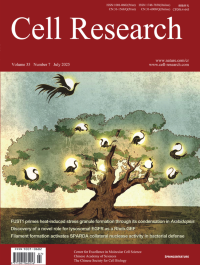Volume 35
-
No. 7 July 2025
The Fusang Tree described in ancient Chinese Classic of Mountains and Seas stands for the intrinsically disordered and multivalent protein FUST1. The suns represent the cores of heat stress granules. FUST1 drives the assembly of heat stress granules via its condensation. See page 483–496 by Pan Geng et al. for details. Cover art is contributed by Zitong Yang.
-
No. 6 June 2025
The unique autophagy mechanism in RAS-mutated cancer cells is depicted, with glowing dots representing activation of RAS-induced non-canonical autophagy via ATG8ylation (RINCAA) and PI4KB S256/T263 phosphorylation. Five multilaminar structures illustrate RAS-induced multivesicular/ multilaminar bodies of ATG8ylation (RIMMBA), which support tumor survival. Light beams symbolize the therapeutic potential of RINCAA-targeting strategies. Art design by Rui Xie. See page 399–422 by Xiaojuan Wang et al. for details.
-
No. 5 May 2025
In Chapter Two of The Secret Life of Sperm, spermatogenesis unfolds as a chromatin symphony. From the pianist spermatogonial stem cell, melodies spiral into Rimsky-Korsakov’s Scheherazade. SETD1B, under RFX2's baton, etches broad H3K4me3 arcs across chromatin. These golden domains outshine their narrow kin, recruit Pol II, and fine- tune transcriptional timing. Stage by stage, shimmering notes guide the epigenetic choreography that shapes the germ cell’s fate. See page 345–361 by Zhen Lin et al. for details.
-
No. 4 April 2025
To help the soldiers (T cells) better identify spies (non-self antigens, marked in blue) and protect the city, while avoiding harm to normal citizens (self-antigens, marked in orange), we need to improve the functionalities of two weapons: a blue glove or a blue goggle (T cell receptor, TCR) and a sword or a bow (CD8). Optimization of both weapons and their cooperation will significantly strengthen the soldiers’ power. See page 265–283 by Rui Qin et al. for details.
-
No. 3 March 2025
This image symbolizes the identification of the noncanonical proteome, where scattered glimmers of light (peptides) converge to form a radiant lamp (proteome). The quest to uncover noncanonical proteins is likened to seeking a flicker of firelight in the darkness. In this study, a hidden peptidome has been unearthed and transformed into a radiant beacon, illuminating uncharted pathways for future proteomic research. See page 186–204 by Chengyu Shi et al. for details.
-
No. 2 February 2025
The old Chinese philosophical concept states, “The Tai Chi gives rise to the Two Forms (Yin and Yang), which generate the Four Symbols (Si Xiang)”. The positive (Yang) and negative (Yin) regulations of the immune system drive different patterns of immune homeostasis. For example, RelA-TTP-GLO2-SLG functions as the Four Symbols, which are mutually regulated, ensuring precise control of the immune system to prevent excessive inflammation and tissue damage. See page 97–116 by Qihang Zhao et al. for details.
-
No. 1 January 2025
The dual effects of glucocorticoids (GCs) are illustrated by bees. Left, low levels of GCs bind to the canonical high-affinity GC receptor (GR, the flower producing honey), mediating physiological and therapeutic effects. Right, high levels of GCs can also bind to the low-affinity receptor, tau, leading to bone loss and demonstrating pathological effects. See page 23–44 by Wenyu Fu et al. for details.







